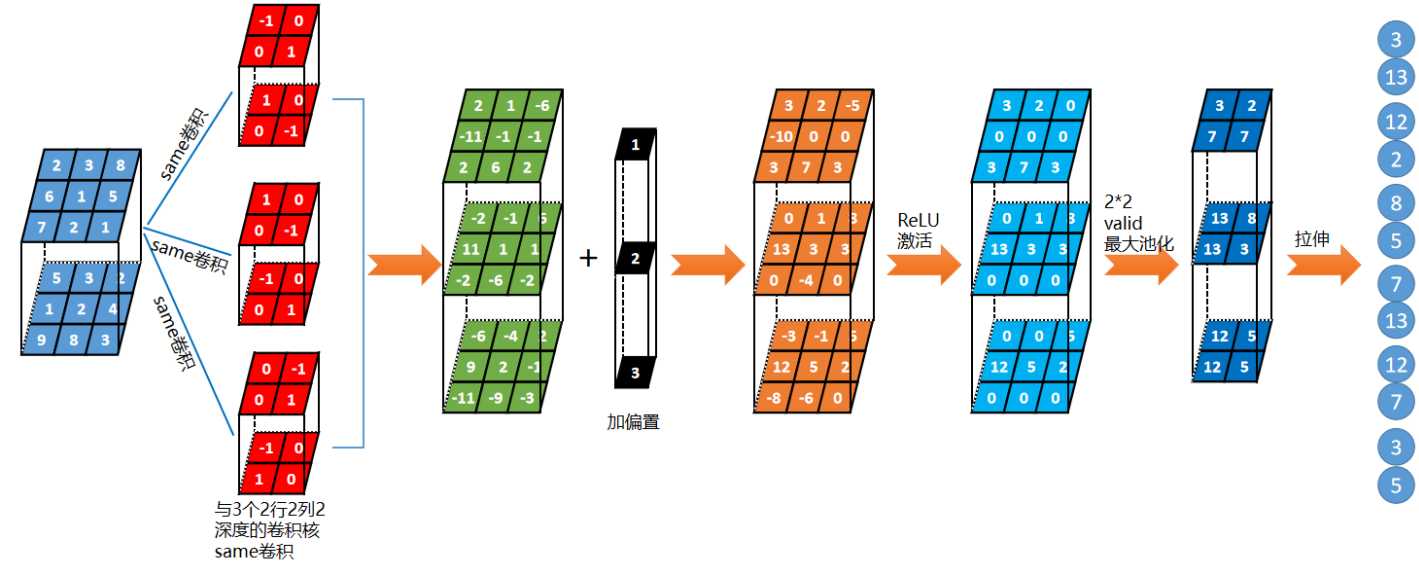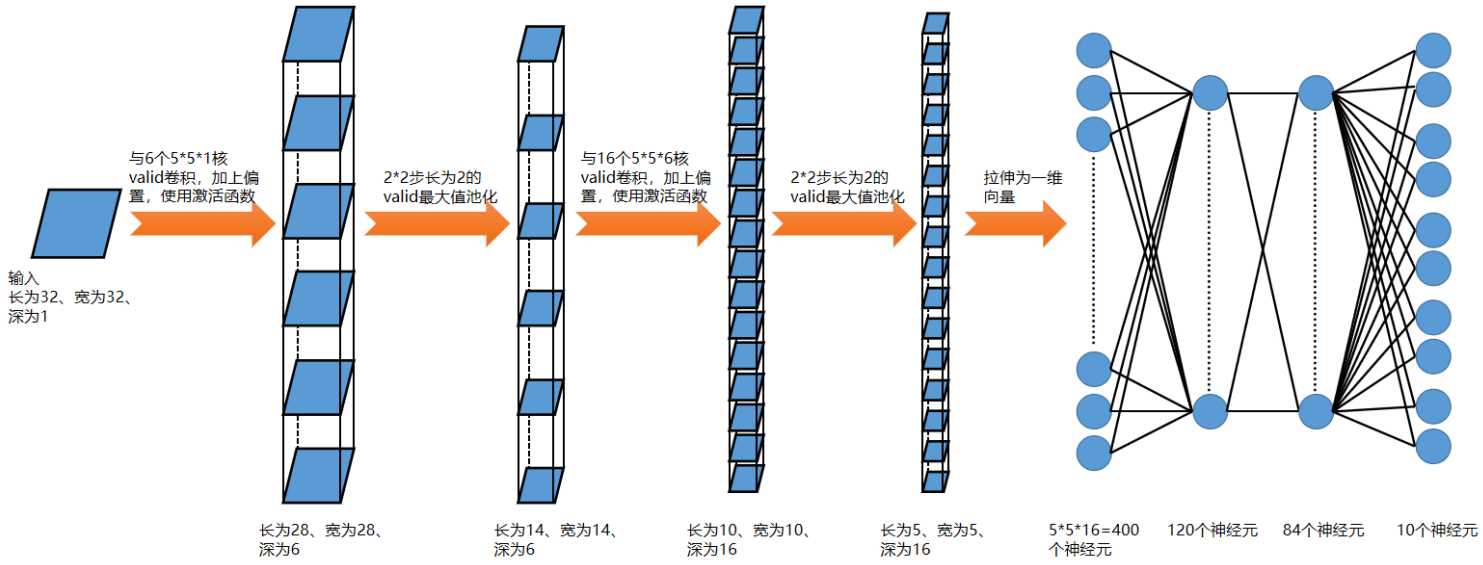标签:epo 池化层 exe fit 通道 binary mode val min
LeNet是卷积神经网络的祖师爷LeCun在1998年提出,用于解决手写数字识别的视觉任务。自那时起,CNN的最基本的架构就定下来了:卷积层、池化层、全连接层。如今各大深度学习框架中所使用的LeNet都是简化改进过的LeNet-5(-5表示具有5个层),和原始的LeNet有些许不同,比如把激活函数改为了现在很常用的ReLu。
|
神经网络的卷积、池化、拉伸 |
前面讲了卷积和池化,卷积层可以从图像中提取特征,池化层可以进行特征压缩,拉伸是为了和全连接网络相连接。

|
LeNet网络结构 |
LeNet是第一个成熟的卷积神经网络,是专门为处理MNIST数字字符集的分类问题而设计的网络,其网络如下:

|
LeNet在MNIST数据集上应用 |
显示图像
Mnist数据集中图像尺寸是28*28的,为了贴合LeNet网络的设计,我们可以将其扩展为32*32的,其实应用网络的变种也是很常见的。

im = X_train[0] from PIL import Image import numpy as np img = np.array(im) # image类 转 numpy # img = img[:,:,0] #第1通道 im=Image.fromarray(img) # numpy 转 image类 im.show()

可以将其上下左右增加0像素,扩展为32*32

很明显,黑色的边框变大了一些

from keras import backend as K
from keras.models import Sequential
from keras.layers.convolutional import Conv2D
from keras.layers.convolutional import MaxPooling2D
from keras.layers.core import Activation
from keras.layers.core import Flatten
from keras.layers.core import Dense
from keras.datasets import mnist
from keras.utils import np_utils
from keras.optimizers import SGD, RMSprop, Adam
import numpy as np
import matplotlib.pyplot as plt
np.random.seed(1671) # for reproducibility
# define the convnet
class LeNet:
@staticmethod
def build(input_shape, classes):
model = Sequential()
# CONV => RELU => POOL
model.add(Conv2D(6, kernel_size=5, padding="valid",
input_shape=input_shape))
model.add(Activation("relu"))
model.add(MaxPooling2D(pool_size=(2, 2), strides=(2, 2)))
# CONV => RELU => POOL
model.add(Conv2D(16, kernel_size=5, padding="valid"))
model.add(Activation("relu"))
model.add(MaxPooling2D(pool_size=(2, 2), strides=(2, 2)))
# Flatten => RELU layers
model.add(Flatten())
model.add(Dense(400))
model.add(Activation("relu"))
model.add(Dense(120))
model.add(Activation("relu"))
model.add(Dense(84))
model.add(Activation("relu"))
# a softmax classifier
model.add(Dense(classes))
model.add(Activation("softmax"))
return model
# network and training
NB_EPOCH = 20
BATCH_SIZE = 128
VERBOSE = 1
OPTIMIZER = Adam()
VALIDATION_SPLIT = 0.2
IMG_ROWS, IMG_COLS = 32, 32 # input image dimensions
NB_CLASSES = 10 # number of outputs = number of digits
INPUT_SHAPE = (1, IMG_ROWS, IMG_COLS)
# data: shuffled and split between train and test sets
(X_train, y_train), (X_test, y_test) = mnist.load_data(path=‘D:/mnist.npz‘)
b = np.array([
[[0]*28]*2
]*60000)
X_train = np.hstack((b,X_train))
X_train = np.hstack((X_train,b))
b = np.array([
[[0]*28]*2
]*10000)
X_test = np.hstack((b,X_test))
X_test = np.hstack((X_test,b))
b = np.array([
[[0]*2]*32
]*60000)
X_train = np.c_[b,X_train]
X_train = np.c_[X_train,b]
b = np.array([
[[0]*2]*32
]*10000)
X_test = np.c_[b,X_test]
X_test = np.c_[X_test,b]
K.set_image_dim_ordering("th")
# consider them as float and normalize
X_train = X_train.astype(‘float32‘)
X_test = X_test.astype(‘float32‘)
X_train /= 255
X_test /= 255
# we need a 60K x [1 x 28 x 28] shape as input to the CONVNET
X_train = X_train[:, np.newaxis, :, :]
X_test = X_test[:, np.newaxis, :, :]
print(X_train.shape[0], ‘train samples‘)
print(X_test.shape[0], ‘test samples‘)
# convert class vectors to binary class matrices
y_train = np_utils.to_categorical(y_train, NB_CLASSES)
y_test = np_utils.to_categorical(y_test, NB_CLASSES)
# initialize the optimizer and model
model = LeNet.build(input_shape=INPUT_SHAPE, classes=NB_CLASSES)
model.compile(loss="categorical_crossentropy", optimizer=OPTIMIZER,
metrics=["accuracy"])
history = model.fit(X_train, y_train,
batch_size=BATCH_SIZE, epochs=NB_EPOCH,
verbose=VERBOSE, validation_split=VALIDATION_SPLIT)
score = model.evaluate(X_test, y_test, verbose=VERBOSE)
print("\nTest score:", score[0])
print(‘Test accuracy:‘, score[1])
# list all data in history
print(history.history.keys())
# summarize history for accuracy
plt.plot(history.history[‘acc‘])
plt.plot(history.history[‘val_acc‘])
plt.title(‘model accuracy‘)
plt.ylabel(‘accuracy‘)
plt.xlabel(‘epoch‘)
plt.legend([‘train‘, ‘test‘], loc=‘upper left‘)
plt.show()
# summarize history for loss
plt.plot(history.history[‘loss‘])
plt.plot(history.history[‘val_loss‘])
plt.title(‘model loss‘)
plt.ylabel(‘loss‘)
plt.xlabel(‘epoch‘)
plt.legend([‘train‘, ‘test‘], loc=‘upper left‘)
plt.show()
运行结果:

zhaoyichen@ubuntu:~/dl1701/dl12_LeNet$ python test.py
/home/zhaoyichen/anaconda3/lib/python3.6/site-packages/h5py/__init__.py:36: FutureWarning: Conversion of the second argument of issubdtype from `float` to `np.floating`type(float).type`.
from ._conv import register_converters as _register_converters
Using TensorFlow backend.
WARNING:tensorflow:From /home/zhaoyichen/anaconda3/lib/python3.6/site-packages/tensorflow/python/framework/op_def_library.py:263: colocate_with (from tensorflow.python..
Instructions for updating:
Colocations handled automatically by placer.
60000 train samples
10000 test samples
2019-07-15 15:24:35.248433: I tensorflow/core/platform/cpu_feature_guard.cc:141] Your CPU supports instructions that this TensorFlow binary was not compiled to use: AVX
2019-07-15 15:24:37.223646: I tensorflow/compiler/xla/service/service.cc:150] XLA service 0x56019785d2e0 executing computations on platform CUDA. Devices:
2019-07-15 15:24:37.223826: I tensorflow/compiler/xla/service/service.cc:158] StreamExecutor device (0): GeForce RTX 2080 Ti, Compute Capability 7.5
2019-07-15 15:24:37.223844: I tensorflow/compiler/xla/service/service.cc:158] StreamExecutor device (1): GeForce RTX 2080 Ti, Compute Capability 7.5
2019-07-15 15:24:37.223877: I tensorflow/compiler/xla/service/service.cc:158] StreamExecutor device (2): GeForce RTX 2080 Ti, Compute Capability 7.5
2019-07-15 15:24:37.223893: I tensorflow/compiler/xla/service/service.cc:158] StreamExecutor device (3): GeForce RTX 2080 Ti, Compute Capability 7.5
2019-07-15 15:24:37.250787: I tensorflow/core/platform/profile_utils/cpu_utils.cc:94] CPU Frequency: 2194925000 Hz
2019-07-15 15:24:37.256673: I tensorflow/compiler/xla/service/service.cc:150] XLA service 0x5601979a1e10 executing computations on platform Host. Devices:
2019-07-15 15:24:37.256804: I tensorflow/compiler/xla/service/service.cc:158] StreamExecutor device (0): <undefined>, <undefined>
2019-07-15 15:24:37.257714: I tensorflow/core/common_runtime/gpu/gpu_device.cc:1433] Found device 0 with properties:
name: GeForce RTX 2080 Ti major: 7 minor: 5 memoryClockRate(GHz): 1.545
pciBusID: 0000:83:00.0
totalMemory: 10.76GiB freeMemory: 9.84GiB
2019-07-15 15:24:37.257828: I tensorflow/core/common_runtime/gpu/gpu_device.cc:1433] Found device 1 with properties:
name: GeForce RTX 2080 Ti major: 7 minor: 5 memoryClockRate(GHz): 1.545
pciBusID: 0000:84:00.0
totalMemory: 10.76GiB freeMemory: 10.34GiB
2019-07-15 15:24:37.257913: I tensorflow/core/common_runtime/gpu/gpu_device.cc:1433] Found device 2 with properties:
name: GeForce RTX 2080 Ti major: 7 minor: 5 memoryClockRate(GHz): 1.545
pciBusID: 0000:87:00.0
totalMemory: 10.76GiB freeMemory: 10.60GiB
2019-07-15 15:24:37.257995: I tensorflow/core/common_runtime/gpu/gpu_device.cc:1433] Found device 3 with properties:
name: GeForce RTX 2080 Ti major: 7 minor: 5 memoryClockRate(GHz): 1.545
pciBusID: 0000:88:00.0
totalMemory: 10.76GiB freeMemory: 10.60GiB
2019-07-15 15:24:37.258834: I tensorflow/core/common_runtime/gpu/gpu_device.cc:1512] Adding visible gpu devices: 0, 1, 2, 3
2019-07-15 15:24:37.268400: I tensorflow/core/common_runtime/gpu/gpu_device.cc:984] Device interconnect StreamExecutor with strength 1 edge matrix:
2019-07-15 15:24:37.268438: I tensorflow/core/common_runtime/gpu/gpu_device.cc:990] 0 1 2 3
2019-07-15 15:24:37.268459: I tensorflow/core/common_runtime/gpu/gpu_device.cc:1003] 0: N N N N
2019-07-15 15:24:37.268473: I tensorflow/core/common_runtime/gpu/gpu_device.cc:1003] 1: N N N N
2019-07-15 15:24:37.268487: I tensorflow/core/common_runtime/gpu/gpu_device.cc:1003] 2: N N N N
2019-07-15 15:24:37.268500: I tensorflow/core/common_runtime/gpu/gpu_device.cc:1003] 3: N N N N
2019-07-15 15:24:37.269057: I tensorflow/core/common_runtime/gpu/gpu_device.cc:1115] Created TensorFlow device (/job:localhost/replica:0/task:0/device:GPU:0 with 9568 M bus id: 0000:83:00.0, compute capability: 7.5)
2019-07-15 15:24:37.270048: I tensorflow/core/common_runtime/gpu/gpu_device.cc:1115] Created TensorFlow device (/job:localhost/replica:0/task:0/device:GPU:1 with 10061 i bus id: 0000:84:00.0, compute capability: 7.5)
2019-07-15 15:24:37.270770: I tensorflow/core/common_runtime/gpu/gpu_device.cc:1115] Created TensorFlow device (/job:localhost/replica:0/task:0/device:GPU:2 with 10310 i bus id: 0000:87:00.0, compute capability: 7.5)
2019-07-15 15:24:37.271325: I tensorflow/core/common_runtime/gpu/gpu_device.cc:1115] Created TensorFlow device (/job:localhost/replica:0/task:0/device:GPU:3 with 10310 i bus id: 0000:88:00.0, compute capability: 7.5)
WARNING:tensorflow:From /home/zhaoyichen/anaconda3/lib/python3.6/site-packages/tensorflow/python/ops/math_ops.py:3066: to_int32 (from tensorflow.python.ops.math_ops) is
Instructions for updating:
Use tf.cast instead.
Train on 48000 samples, validate on 12000 samples
Epoch 1/20
2019-07-15 15:24:41.563183: I tensorflow/stream_executor/dso_loader.cc:152] successfully opened CUDA library libcublas.so.10.0 locally
48000/48000 [==============================] - 16s 325us/step - loss: 0.2900 - acc: 0.9123 - val_loss: 0.0828 - val_acc: 0.9744
Epoch 2/20
48000/48000 [==============================] - 8s 174us/step - loss: 0.0735 - acc: 0.9774 - val_loss: 0.0625 - val_acc: 0.9820
Epoch 3/20
48000/48000 [==============================] - 9s 193us/step - loss: 0.0543 - acc: 0.9829 - val_loss: 0.0528 - val_acc: 0.9837
Epoch 4/20
48000/48000 [==============================] - 8s 171us/step - loss: 0.0400 - acc: 0.9873 - val_loss: 0.0488 - val_acc: 0.9861
Epoch 5/20
48000/48000 [==============================] - 7s 146us/step - loss: 0.0320 - acc: 0.9900 - val_loss: 0.0489 - val_acc: 0.9862
Epoch 6/20
48000/48000 [==============================] - 6s 128us/step - loss: 0.0269 - acc: 0.9915 - val_loss: 0.0428 - val_acc: 0.9881
Epoch 7/20
48000/48000 [==============================] - 8s 165us/step - loss: 0.0223 - acc: 0.9929 - val_loss: 0.0456 - val_acc: 0.9872
Epoch 8/20
48000/48000 [==============================] - 8s 173us/step - loss: 0.0187 - acc: 0.9936 - val_loss: 0.0490 - val_acc: 0.9868
Epoch 9/20
48000/48000 [==============================] - 6s 128us/step - loss: 0.0173 - acc: 0.9941 - val_loss: 0.0573 - val_acc: 0.9835
Epoch 10/20
48000/48000 [==============================] - 6s 133us/step - loss: 0.0148 - acc: 0.9952 - val_loss: 0.0568 - val_acc: 0.9862
Epoch 11/20
48000/48000 [==============================] - 6s 133us/step - loss: 0.0124 - acc: 0.9959 - val_loss: 0.0581 - val_acc: 0.9847
Epoch 12/20
48000/48000 [==============================] - 6s 118us/step - loss: 0.0107 - acc: 0.9968 - val_loss: 0.0528 - val_acc: 0.9873
Epoch 13/20
48000/48000 [==============================] - 6s 131us/step - loss: 0.0105 - acc: 0.9966 - val_loss: 0.0533 - val_acc: 0.9887
Epoch 14/20
48000/48000 [==============================] - 6s 130us/step - loss: 0.0113 - acc: 0.9964 - val_loss: 0.0489 - val_acc: 0.9879
Epoch 15/20
48000/48000 [==============================] - 6s 130us/step - loss: 0.0059 - acc: 0.9980 - val_loss: 0.0735 - val_acc: 0.9852
Epoch 16/20
48000/48000 [==============================] - 6s 130us/step - loss: 0.0117 - acc: 0.9959 - val_loss: 0.0559 - val_acc: 0.9881
Epoch 17/20
48000/48000 [==============================] - 6s 127us/step - loss: 0.0065 - acc: 0.9980 - val_loss: 0.0475 - val_acc: 0.9889
Epoch 18/20
48000/48000 [==============================] - 6s 118us/step - loss: 0.0074 - acc: 0.9975 - val_loss: 0.0593 - val_acc: 0.9876
Epoch 19/20
48000/48000 [==============================] - 6s 135us/step - loss: 0.0086 - acc: 0.9969 - val_loss: 0.0537 - val_acc: 0.9886
Epoch 20/20
48000/48000 [==============================] - 6s 133us/step - loss: 0.0056 - acc: 0.9984 - val_loss: 0.0555 - val_acc: 0.9880
10000/10000 [==============================] - 1s 134us/step
Test score: 0.041087062359685976
Test accuracy: 0.9906
PS:代码中的激活函数选择的是ReLU,但是ReLU其实是AlexNet中提出的。
Mnist数据集如果下载比较慢的话,可以加入QQ群:537594183获取数据集
|
参考资料 |
《图解深度学习与神经网络:从张量到TensorFlow实现》_张平
《Keras深度学习实战》_王海玲等译
标签:epo 池化层 exe fit 通道 binary mode val min
原文地址:https://www.cnblogs.com/itmorn/p/11190971.html